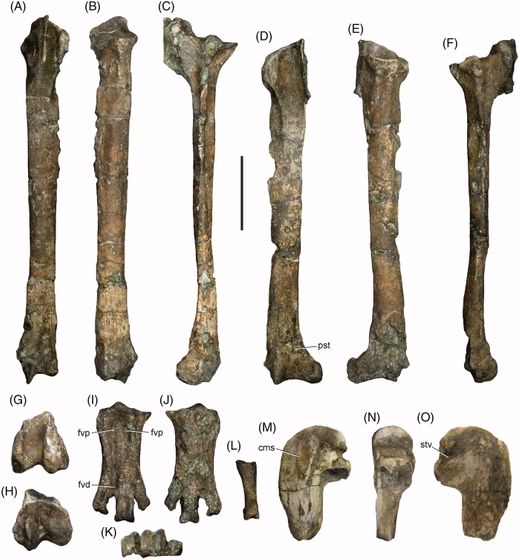A human-sized giant penguin fossil is excavated in New Zealand

The
Leg bones of a new penguin species from the Waipara Greensand add to the diversity of very large-sized Sphenisciformes in the Paleocene of New Zealand: Alcheringa: An Australasian Journal of Palaeontology: Vol 0, No 0
https://www.tandfonline.com/doi/full/10.1080/03115518.2019.1641619
A Human-Sized Penguin Fossil Has Turned Up in New Zealand, Again
https://www.sciencealert.com/another-ancient-human-sized-penguin-fossil-has-turned-up-in-new-zealand
Giant penguin the size of a person wandered New Zealand 66 million years ago | Daily Mail Online
https://www.dailymail.co.uk/sciencetech/article-7354959/Giant-penguin-fossil-New-Zealand.html
A team of paleontologists Gerald Meyer and others at the Senckenberg Institute in Germany discovered a penguin leg bone on the South Island in New Zealand.
This is the fossil of the penguin leg excavated this time.

A comparison of Crossvallia waiparensis and an adult woman looks like this. You can move the 3D model by dragging it.
by Canterbury Museum Sketchfab
Crossvallia waiparensis the Paleocene hits the era, Meyer said to have been inhabited from about 66 million years about 56 million years ago in the New Zealand coast has to guess. It is known that kangaroos, wombats, marsupial lions and others lived in New Zealand at that time, but they were much larger than modern relatives. Is called ' Megafauna '.
The following image compares the megafauna who lived in the same era as Crossvallia waiparensis. A bird that can not fly from the left ` ` Geniornnis (about 2 m in height) '', a giant parrot `` Hercules Inexpectus (about 1 m in height) '', a white marsupial in the foreground ` ` Gigomatrus (about 1.4 m in height) '' brown marsupials ' DIPROTODON (withers about 2m)', a giant kangaroo ' procoptodon is (abt 2m)' and Crossvallia waiparensis (a height of about 1.6m).

Crossvallia waiparensis is so big in size that temperature and survival competition are related. Dr. Paul Scofield, chief curator of the Canterbury Museum, said, “When the Crossvallia species lived, the Antarctic was so warm that it was covered with forest, and the temperature in New Zealand was very high,” Talking The size of the penguin has grown steadily due to the abundance of food in this warm climate and the survival competition between species of breeding grounds.
Also, the Dinosaur is almost extinct, the dinosaur that was the protagonist of the previous Cretaceous period, and it seems that the huge predator who threatened animals disappeared . However, Crossvallia waiparensis has since lost its survival competition with other marine mammals and eventually became extinct.
In addition, on the same South Island of New Zealand where Crossvallia waiparensis was found, many huge penguin bones have been found so far, and in 2017 a fossil of penguin Kumimanu biceae, which is said to have reached 177 cm in length, was excavated. It was.
The largest new penguin fossil of the same size as humans is discovered-gigazine

Related Posts:






